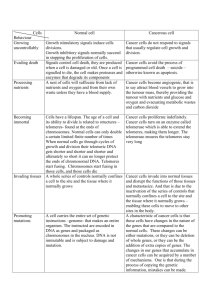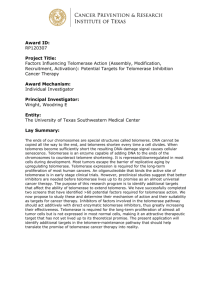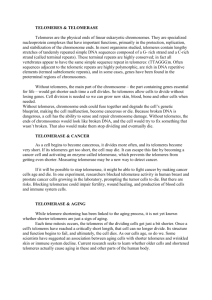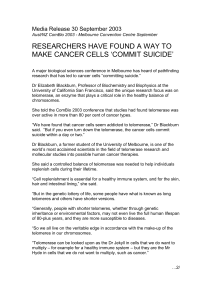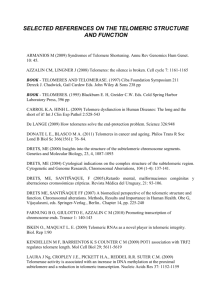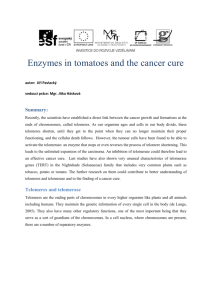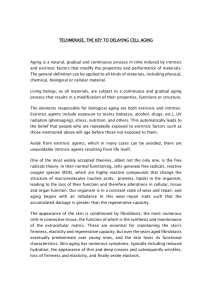Telomeres and the Science of Aging
advertisement
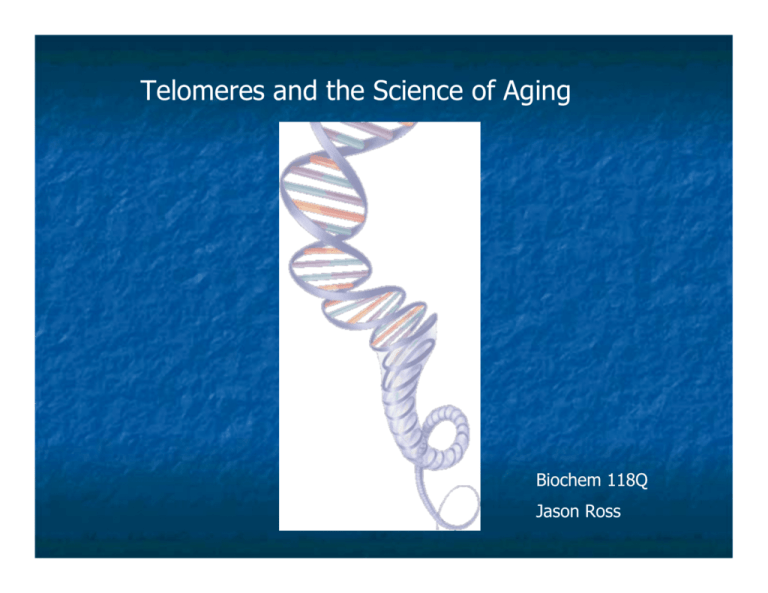
Telomeres and the Science of Aging Biochem 118Q Jason Ross Cells Don’t Live Forever n n Individual cells in culture have a limited life span Almost all cells except for cancer cells obey the Hayflick Limit ~50 cell divisions Does cellular aging have anything to do with the aging of an organism? Molecular Basis for Hayflick Limit n n n n n There is a mechanism associated with the Hayflick limit As cells divide, telomeres shorten Telomeres protect the chromosome from damage and degradation They cap the ends of human chromosomes Composed of (5'-TTAGGG-3‘)n repeats Telomeres n n Specialized nucleoprotein structures Composed of repeated DNA fragments and specific DNA-binding proteins Telomere Function Caps that guard chromosomes ÿ Against degradation ÿ Against chromosomal end-joining ÿ Against recognition as DNA fragments n Telomeres Help Stabilize the Genome n n n n The ends of the linear chromosomes, when unprotected, resemble DNA with broken ends This can lead to chromosomal aberrations such as translocations and inversions By capping the ends of linear chromosomes, the loss of coding sequences that would occur due to the end-replication problem is minimized. The greater the length of the telomeres, the more stable the genome. Telomere Function n n Telomere sequences are progressively lost during cell division in culture at a rate of 50–200 bp per division in humans Once they shorten below a critical length, they lose the capacity to cap chromosomes effectively, resulting in activation of a DNA damage response mechanism A Telomere with Protein Complex Evidence for Longevity n n n Cancer cells are capable of unlimited replication in vitro These cells maintain stable telomere lengths. These findings indicate that telomeres might serve as a molecular device that counts cell divisions and limits cell life Evidence for Longevity n n After extended periods of time in vitro, normal human cells enter an irreversible growth arrest called senescence The telomeres in these cells shorten with each successive replication The Difference n n One difference between cancer cells and normal cells in vitro is the expression of the Telomerase protein Telomerase is responsible for the lengthening of telomeres The End-Replication Problem n n It was recognized in the early 1970s that DNA polymerases would be unable to replicate the very end of linear DNA molecules Because of the inability to replicate the 3' end of chromosomes by DNA polymerases, telomeres are shortened by 50–200 bp per cell division in normal somatic cells. The End-Replication Problem Telomerase n n n A reverse transcriptase (copies single stranded DNA and RNA) adds TTAGGG repeats onto the telomeres that enables unlimited division of the cell Detected in cancer, embryonic, and stem cells but not in somatic cells Telomerase n 1) 2) n Two Human Telomerase subunits: RNA component (hTERC) provides the template for the telomere synthesis reaction Catalytic component (hTERT) rate-limiting component of the telomerase enzyme Subunits elongate telomeres by reading from the RNA template sequence carried by the RNA subunit and synthesizing a complementary DNA strand. Telomerase Protein Telomerase in Action http://www.uni-stuttgart.de/bio/zoologie/telomerase7.htm http://faculty.plattsburgh.edu/donald.slish/Telomerase.html Summary n n Telomere length seems to correlate with cell longevity (length shortens during somatic cell division) Telomerase is responsible for lengthening of telomeres Practical Applications n n n Cancer therapies Cloning Longevity Cancer n n n n Unlimited replication is among the most common characteristics exhibited by human cancer cells Telomerase is exhibited in about 90% of Cancer cells Telomerase inhibitors are being considered as potential anticancer drugs Absence of telomerase activity causes replication senescence and cell death Cancer n n n Telomerase inhibitors are being considered as potential anticancer drugs Absence of telomerase activity causes replication senescence and cell death Assessment of telomere length can be used as a diagnostic tool Cancer ß It is possible that telomere shortening is a way of protecting cells against becoming cancerous ß However, more than the presence of telomerase is necessary for cancer growth Cloning-Dolly n n n n Dolly was the first cloned sheep She was cloned from a 6 year old sheep The length of Dolly’s telomeres was consistent with cells from a sheep that should have been six years older Dolly died prematurely and showed premature signs of aging (arthritis) What Can be Learned from Dolly n n n Although Dolly’s telomeres were shortened by cloning, Nuclear Transfer with mice and cattle actually yield clones with longer telomeres (possibly due to blast cells) The influence on humans is not known There is no direct evidence that Dolly’s shortened telomeres were responsible for her quick death or premature aging Practical Applications n Scientists have immortalized somatic human cells a forced activation of telomerase Can Telomeres Give Us More Time? n n n There are a variety of components that are responsible for aging Free radical oxidation is one form of aging Brain and heart cells rarely divide but still age Geron n n n "Geron and its collaborators have cloned telomerase, the cellular immortalizing enzyme which, when reactivated in normal cells, extends their healthy replicative lifespan by preventing telomere erosion” “Geron and the Roslin Institute will collaborate to combine telomerase activation with nuclear transfer to enable the efficient production of cloned transgenic animals with normal, full-length telomeres” “Geron will also pursue the combination of these technologies with pluripotent stem cell technology to produce human cells and tissues for medical transplantation.... Telomerase activation should provide the transplanted cells and tissues with extended lifespan and hence therapeutic benefit" Problems n n Sometimes more than Telomerase is required In many epithelial cells, expression of both the pRB and p53 tumor-suppressor pathways together with expression of telomerase is required to permit immortalization Fountain of Youth?

